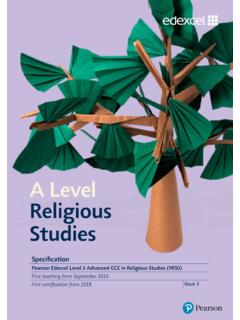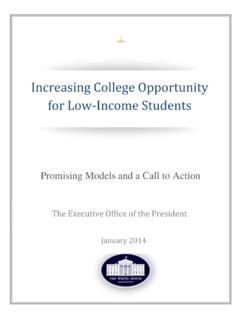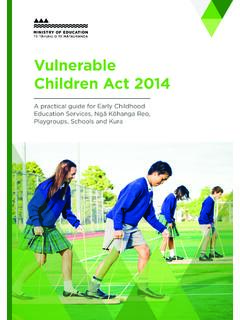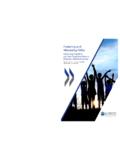Transcription of Breast Cancer Screening Guidelines for Women
1 Breast Cancer Screening Guidelines for Women Preventive Services Task Force1,2 American Cancer Society3 American College of Obstetricians and Gynecologists4,5,6 International Agency for Research on Cancer7 American College of Radiology8,9 American College of Physicians10 American Academy of Family Physicians11 Women aged 40 to 49 years with average risk The decision to start Screening with mammography in Women prior to age 50 years should be an individual one. Women who place a higher value on the potential benefit than the potential harms may choose to begin Screening once every two years between the ages of 40 and 49 years.
2 Women aged 40 to 44 years should have the choice to start Breast Cancer Screening once a year with mammography if they wish to do so. The risks of Screening as well as the potential benefits should be considered. Women aged 45 to 49 years should be screened with mammography annually. After counseling and if an individual desires Screening , mammography may be offered once a year or once every two years and clinical Breast exams may be offered once a year. Decisions between Screening with mammography once a year or once every two years should be made through shared decision-making after appropriate counseling. There is limited evidence that Screening with mammography reduces Breast Cancer mortality in Women 40-49 years of age.
3 Screening with mammography is recommended once a year. Clinicians should discuss whether to screen for Breast Cancer with mammography before age 50 years. Discussion should include the potential benefits and harms and a woman s preferences. The potential harms outweigh the benefits in most Women aged 40 to 49 years. The decision to start Screening with mammography should be an individual one. Women who place a higher value on the potential benefit than the potential harms may choose to begin Screening . Women aged 50 to 74 years with average risk Screening with mammography once every two years is recommended. The evidence is insufficient to assess the additional benefits and harms of clinical Breast examination.
4 Women aged 50 to 54 years should be screened with mammography annually. For Women aged 55 years and older, Screening with mammography is recommended once every two years or once a year. Women aged 55 years and older should transition to biennial Screening or have the opportunity to continue Screening annually. Among average risk Women , clinical Breast examination to screen for Breast Cancer is not recommended. Screening with mammography is recommended once a year or once every two years. Decisions between Screening with mammography once a year or once every two years should be made through shared decision-making after appropriate counseling.
5 Clinical Breast exams may be offered annually. Clinical Breast exams should be offered in the context of a shared, informed decision-making approach that recognizes the uncertainty of additional benefits and harms of clinical Breast examination beyond Screening mammography. There is sufficient evidence that Screening with mammography reduces Breast - Cancer mortality to an extent that its benefits substantially outweigh the risk of radiation-induced Cancer from mammography. There is inadequate evidence that clinical Breast examination reduces Breast Cancer mortality. There is sufficient evidence that clinical Breast examination shifts the stage distribution of tumors detected toward a lower stage.
6 Screening with mammography is recommended once a year. Clinicians should offer Screening with mammography once every two years. In average-risk Women of all ages, clinicians should not use clinical Breast examination to screen for Breast Cancer . Screening with mammography is recommended once every two years. Current evidence is insufficient to assess the benefits and harms of clinical Breast exams. Preventive Services Task Force1,2 American Cancer Society3 American College of Obstetricians and Gynecologists4,5,6 International Agency for Research on Cancer7 American College of Radiology8,9 American College of Physicians10 American Academy of Family Physicians11 Women aged 75 years or older with average risk Current evidence is insufficient to assess the balance of benefits and harms of Screening mammography in Women aged 75 years or older.
7 Women should continue Screening with mammography as long as their overall health is good and they have a life expectancy of 10 years or more. The decision to stop Screening should be based on a shared decision-making process. The decision-making process should include a discussion of the woman s health status and longevity. Not addressed. The age to stop Screening with mammography should be based on each woman s health status rather than an age-based determination. In average-risk Women aged 75 years or older or in Women with a life expectancy of 10 years or less, clinicians should discontinue Screening for Breast Cancer .
8 Current evidence is insufficient to assess the balance of benefits and harms of Screening with mammography. Women with dense breasts Current evidence is insufficient to assess the balance of benefits and harms of adjunctive Screening for Breast Cancer using Breast ultrasonography, magnetic resonance imaging (MRI), digital Breast tomosynthesis (DBT), or other methods in Women identified to have dense breasts on an otherwise negative Screening mammogram. Evidence is insufficient to recommend for or against yearly MRI Screening . Other than Screening with mammography, the organization does not recommend routine use of alternative or additional tests.
9 Health care providers should comply with state laws that may require disclosure to Women of their Breast density as recorded in a mammogram report. There is inadequate evidence that ultrasonography as an adjunct to mammography reduces Breast Cancer mortality. There is limited evidence that ultrasonography as an adjunct to mammography increases the Breast Cancer detection rate. There is sufficient evidence that ultrasonography as an adjunct to mammography increases the proportion of false positive Screening outcomes. In addition to mammography, contrast-enhanced Breast MRI is also recommended. After weighing benefits and risks, ultrasound can be considered for those who cannot undergo MRI.
10 There is insufficient evidence on benefits and harms of Screening strategies in Women who have dense breasts. Current evidence is insufficient to assess the balance of benefits and harms of adjunctive Screening for Breast Cancer using Breast ultrasonography, MRI, DBT, or other methods. Women at high risk Some organizations release different Breast Cancer Screening Guidelines for Women who are considered to be at high risk of developing Breast Cancer . Different Screening Guidelines may be suggested for Women who have risk factors such as a BRCA1 or BRCA2 mutation, who are an untested family member of someone who has a BRCA1 or BRCA2 mutation, who have a history of mantle or chest radiation which occurred before age 30 years, or who have a lifetime Breast Cancer risk of 20% or greater based on their family history.
















